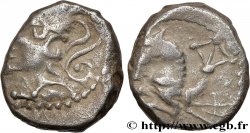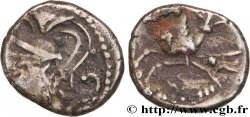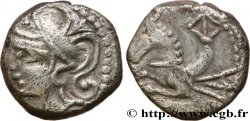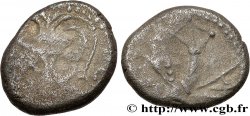v41_1549 - GALLIA - ALLOBROGES (Dauphiné area) Denier VOL ou LOV au cheval et à la rouelle, variante épigraphique
MONNAIES 41 (2009)
Starting price : 320.00 €
Estimate : 600.00 €
Realised price : 395.00 €
Number of bids : 3
Maximum bid : 565.00 €
Starting price : 320.00 €
Estimate : 600.00 €
Realised price : 395.00 €
Number of bids : 3
Maximum bid : 565.00 €
Type : Denier VOL ou LOV au cheval et à la rouelle, variante épigraphique
Date: Ier siècle avant J.-C.
Metal : silver
Diameter : 14 mm
Orientation dies : 3 h.
Weight : 2,13 g.
Rarity : R3
Coments on the condition:
Flan un peu court, avec un droit partiellement décentré mais un superbe revers complet et centré. Patine finement irisée et légèrement poreuse, surtout sur la tranche
Catalogue references :
Obverse
Obverse legend : ANÉPIGRAPHE.
Obverse description : Tête laurée à gauche.
Reverse
Reverse legend : LOV (L RÉTROGRADE).
Reverse description : Cheval galopant à gauche ; au-dessus, la légende ; une rouelle à quatre rayons entre les jambes.
Commentary
L’exemplaire normal, n° 872 de MONNAIES 32 (bien que granuleux) s’est vendu 555€ sur ordre de 610€.
Si le droit de ce denier est décentré, le visage est complet. Le revers est parfait et d’un très beau style, avec une variante épigraphique intéressante : la légende VOL habituellement normale centripète sur tous les exemplaires est normale centrifuge sur cet exemplaire, avec le L initial rétrograde. Cette légende LOV est une variante connue, mais excessivement rare sur ce monnayage !.
Si le droit de ce denier est décentré, le visage est complet. Le revers est parfait et d’un très beau style, avec une variante épigraphique intéressante : la légende VOL habituellement normale centripète sur tous les exemplaires est normale centrifuge sur cet exemplaire, avec le L initial rétrograde. Cette légende LOV est une variante connue, mais excessivement rare sur ce monnayage !.








 Report a mistake
Report a mistake Print the page
Print the page Share my selection
Share my selection Ask a question
Ask a question Consign / sell
Consign / sell
 Full data
Full data










